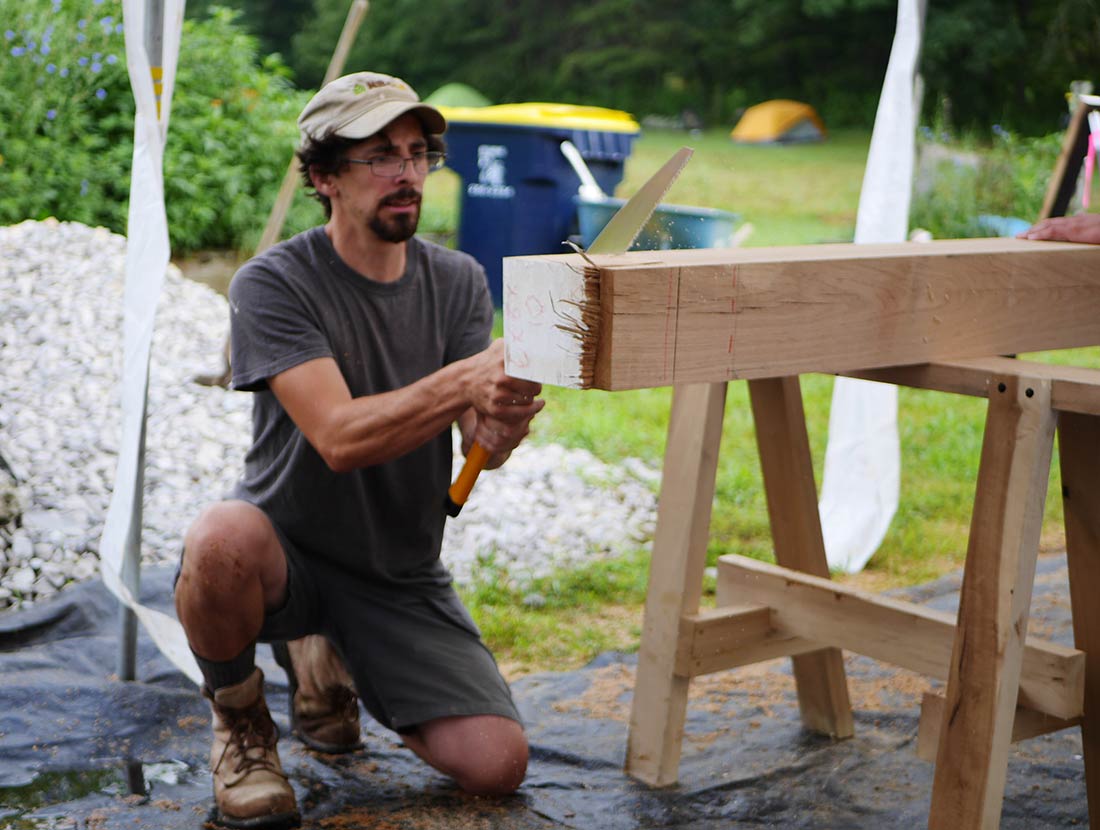If you’re building a timber frame with hand tools, it’s helpful to have a few types of hand saws in your arsenal. There are many many types of saws that you could use, and at the end of the day it boils down to personal preference. Me? I like to try new tools from time to time, and these are two that I find very effective in the cutting process — a Japanese anahiki saw (or timber saw), and a Japanese ryoba saw (or two sided saw).
2 Japanese Saws for Timber Framing
We like to emphasize the use of hand tools in our workshops because they’re generally safe to use and folks can still talk while working without worrying about hearing protection every few moments. Using hand tools is a better way to learn about wood and wood grain because you’re not just tearing through grain with high power. You can easily feel changes in grain direction within a timber through the use of a hand saw, chisel, etc.
Japanese Timber Saw: Z-SAW 333
There’s a type of Japanese saw called an anahiki saw that has a long, slender blade that’s tapered along the length. These are fast-cutting, fairly aggressive saws useful for large dimension wood. The one pictured above is a Z-SAW 333 (333 referring to the length in mm, basically slightly over 13″ long.) The Z-SAW leaves a very clean cut and is useful for end cuts or shoulder cuts where precision and appearance are a factor. They can also be used for kerfing (cuts through a partial depth of the wood before waste removal with a chisel or axe). Though they’re probably better reserved for small kerf cuts because there are even more aggressive saws for deeper or more frequent kerf cuts (on a long tenon, for example.)
I’ve noticed that this type of saw can be used very effectively by a beginner. Assuming you start your cut straight (which is not that difficult once you’ve done it a few times), you’ll end up with a very even cut. One nice thing about Japanese saws in general is that the blades are very thin, so you’re not removing a huge amount of material with each stroke. The saws are lightweight and easy to work with. The rubberized handle on the Z-SAW is very comfy too.
I found this Z-SAW 333 for about $30, which is a pretty darn good price for a saw that should last quite a while before blade sharpening or replacement. Look around for good deals, especially on eBay. For the price it’s a much higher quality saw than you can get at the hardware store.
Ryoba Saw: Two Blades in One
The ryoba is probably the better known of the Japanese saw designs. These are extremely useful for all sorts of carpentry and woodworking tasks. They have both crosscut and rip teeth on the same blade. The design is very traditional and frankly a bit of genius. Ryoba saws can be found in various lengths, but the most useful for timber framing tend to be the biggest you can find, usually at least 300 mm in length. As ryoba saws increase in length, the teeth are sized and spaced to make more aggressive cuts. (Therefore a 210 mm length ryoba will have finer teeth compared to a 300 mm, for example.) Anything less than 300 mm in length is not that useful for large timbers.
Again, the crosscut side is very useful for finish cuts, say at the end of a timber or a shoulder cut. These suckers are clean-cutting and can be used in a variety of body positions. You’ll have to see what works best for you. Important to note is that you should be in line with the blade to ensure a straight cut. It’s a slight adjustment from using a western-style saw.
The rip side of a ryoba is equally useful, especially for tasks like making reduction cuts on a tenon. I find the body positioning when using these types of saws to be a natural fit when working with large timbers.
Gyokucho brand ryoba saws are ubiquitous across the internet, and a good value (especially considering that it’s essentially two saws in one.) The blades last a long time and can actually be sharpened. The teeth are a little brittle and can snap off if you’re not careful, but in normal use it’s not an issue.
Do you have any favorites to add to the list?





